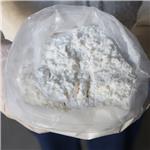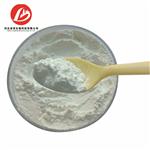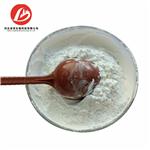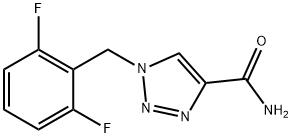Rufinamide
- CAS No.
- 106308-44-5
- Chemical Name:
- Rufinamide
- Synonyms
- 1-(2,6-Difluorobenzyl)-1H-1,2,3-triazole-4-carboxamide;E 2080;RUF 331;CS-1133;Inovelon;CGP 33101;Rufinamide;Rufinamide>Rufinamide, >=99%;Rufinamide(E 2080
- CBNumber:
- CB5972298
- Molecular Formula:
- C10H8F2N4O
- Molecular Weight:
- 238.19
- MDL Number:
- MFCD00865314
- MOL File:
- 106308-44-5.mol
- MSDS File:
- SDS
| Melting point | 232-234?C |
|---|---|
| Boiling point | 473.8±55.0 °C(Predicted) |
| Density | 1.52±0.1 g/cm3(Predicted) |
| Flash point | 2℃ |
| storage temp. | -20°C |
| solubility | DMSO: soluble9mg/mL |
| pka | 14.37±0.50(Predicted) |
| form | powder |
| color | white |
| Merck | 14,8293 |
| Stability | Stable for 1 year from date of purchase as supplied. Solutions in DMSO may be stored at -20°C for up to 1 month. |
| FDA UNII | WFW942PR79 |
| ATC code | N03AF03 |
SAFETY
Risk and Safety Statements
| Symbol(GHS) |   GHS07,GHS08 |
|---|---|
| Signal word | Warning |
| Hazard statements | H336-H351-H361fd |
| Precautionary statements | P201-P202-P261-P271-P280-P308+P313 |
| Hazard Codes | F,T |
| Risk Statements | 11-23/24/25-39/23/24/25-48-41-38-28 |
| Safety Statements | 7-16-36/37-45-36/37/39-28-26-24/25 |
| RIDADR | UN 1648 3 / PGII |
| WGK Germany | 3 |
| HS Code | 29339900 |
Rufinamide price More Price(40)
| Manufacturer | Product number | Product description | CAS number | Packaging | Price | Updated | Buy |
|---|---|---|---|---|---|---|---|
| Sigma-Aldrich | R-023 | Rufinamide solution 1.0?mg/mL in acetonitrile: water (9:1), certified reference material, Cerilliant? | 106308-44-5 | 1mL | $161 | 2024-03-01 | Buy |
| Sigma-Aldrich | 1606401 | Rufinamide United States Pharmacopeia (USP) Reference Standard | 106308-44-5 | 200mg | $1290 | 2024-03-01 | Buy |
| Sigma-Aldrich | PHR1625 | Rufinamide | 106308-44-5 | 500mg | $152 | 2022-05-15 | Buy |
| TCI Chemical | R0143 | Rufinamide >98.0%(HPLC) | 106308-44-5 | 25mg | $16 | 2024-03-01 | Buy |
| TCI Chemical | R0143 | Rufinamide >98.0%(HPLC) | 106308-44-5 | 100mg | $42 | 2024-03-01 | Buy |
Rufinamide Chemical Properties,Uses,Production
Description
Rufinamide (licensed in 2007) is a third- generation AED known with the proprietary
brand name of Invelon®(Eisai, Hatfield) in the UK and USA.
Generic formulation
MHRA/ CHM advice to minimize risk when switching patients with epilepsy between different manufacturers’ products (including generic products):
- The need for continued supply of a particular manufacturer’s product should be based on clinical judgment and consultation with the patient and/ or carer taking into account factors such as seizure frequency and treatment history.
Indications
Epilepsy: Adjunctive treatment of Lennox– Gastaut syndrome; refractory tonic/ atonic seizures (unlicensed).
Dose titration
- Epilepsy— adjunctive therapy (adults with body weight 30– 50 kg): 200 mg bd for at least 2 days, then increased by 200 mg bd every 2 or more days (max. 900 mg bd).
- Epilepsy— adjunctive therapy (adults with body weight 50– 70 kg): 200 mg bd for at least 2 days, then increased by 200 mg bd every 2 or more days (max. 1200 mg bd).
- Epilepsy— adjunctive therapy (adults with body weight above 70 kg): 200 mg bd for at least 2 days, then increased by 200 mg bd every 2 or more days (max. 1600 mg bd).
Interactions
With AEDs
Significant increases in rufinamide plasma concentrations may occur with coadministration of valproate.
With other drugs
- Women of child- bearing age using hormonal contraceptives are advised to use an additional safe and effective contraceptive method as co- administration of rufinamide has been shown to decrease exposure to a combined oral contraceptives.
- Rufinamide has been shown to induce the cytochrome P450 enzyme CYP3A4 and may, therefore, reduce the plasma concentrations of substances, which are metabolized by this enzyme (modest- to- moderate effect). It is therefore recommended that patients treated with substances that are metabolized by the CYP3A4 enzyme system are to be carefully monitored for 2 weeks at the start of or after the end of treatment with rufinamide, or after any marked change in the dose (a dose adjustment of the concomitantly administered medicinal product may need to be considered). These recommendations should also be considered when rufinamide is used concomitantly with substances with a narrow therapeutic window, such as warfarin and digoxin.
- No data on the interaction of rufinamide with alcohol are available • As a food effect was observed, rufinamide should be administered with food
Special populations
Hepatic impairment
- Caution and careful dose titration in mild- to- moderate impairment
- Avoid in severe impairment
Renal impairment
The pharmacokinetics of rufinamide does not appear to be altered in subjects with chronic and severe renal failure compared to healthy volunteers
Pregnancy
- No clinical data are available on pregnancies exposed to rufinamide. Therefore, rufinamide should not be used during pregnancy or in women of childbearing age who are not using contraceptive measures, unless clearly necessary. Women of childbearing age must use contraceptive measures during treatment with rufinamide.
- If women treated with rufinamide plan to become pregnant, the continued use of this product should be carefully weighed. In case of treatment with rufinamide, the dose should be monitored carefully during pregnancy and after birth, and adjustments made on a clinical basis.
- It is not known if rufinamide is excreted in human breastmilk. Due to the potential harmful effects for the breastfed infant, breastfeeding should be avoided during maternal treatment with rufinamide.
Behavioural and cognitive effects in patients with epilepsy
For this third- generation agent, clinical experience is still limited, and little is known about its positive and negative psychotropic properties, and their implications for the management of behavioural symptoms in patients with epilepsy. There are initial reports of anxiety, depression, irritability, and agitation. Reports of cognitive effects are rare.
Psychiatric use
Rufinamide has no indications for the treatment of psychiatric disorders. There is insufficient experience with rufinamide to draw any conclusion regarding its psychotropic profile.
Description
Approximately 2.5 million people worldwide are afflicted with epilepsy, a devastating neurological disorder diagnosed by the tendency toward recurrent, unprovoked seizures, often of unknown etiology. Rufinamide has been launched primarily as adjunctive therapy of LGS. Its proposed mechanism of action involves the limitation of firing of sodium-dependent action potentials. The ultimate result is membrane stabilization. Since it does not exhibit measurable binding to monoamine, acetylcholine, histamine, glycine, AMPA/kainate, NMDA, or GABA receptors or systems, these receptor-mediated pathways are not anticipated to be involved in the exertion of rufinamide’s effects. Rufinamide displayed efficacy in several electrical and chemical animal seizure models.
Description
Lennox-Gastaut syndrome (LGS) is a severe pediatric epilepsy syndrome characterized by multiple seizure types. Rufinamide is an anticonvulsant. It inhibits the activation of voltage-gated sodium channel 1.1 (Nav1.1) when used at a concentration of 100 μM. Rufinamide inhibits Nav1.1, but not Nav1.2, Nav1.3, and Nav1.6, opening and increases the action potential threshold in primary rat hippocampal neurons. It is an inhibitor of carbonic anhydrase VA (CAVA; Ki = 343.8 nM) that is selective for CAVA over CAI and CAII (Kis = >10,000 nM for both). Rufinamide (100 μM) prolongs the preictal phase and reduces seizure-like event frequency in an in vitro model of epileptiform activity in rat hippocampal slices. It inhibits seizures induced by pentylenetetrazole in a mouse model of epilepsy (ED50 = 54 mg/kg, i.p.) and reduces kainic acid-induced neuronal cell death in the mouse hippocampal CA3 region when used at doses of 25, 50, and 100 mg/kg. Formulations containing rufinamide have been used in the treatment of seizures associated with Lennox-Gastaut Syndrome (LGS).
Chemical Properties
White Solid
Originator
Novartis (US)
Uses
Rufinamide, a triazole derivative, is an anticonvulsant medication. It is used in combination with other medication and therapy to treat Lennox–Gastaut syndrome and various other seizure disorders. Rufinamide is presumed to involve stabilization of the so
Uses
Labelled Rufinamide (R701552). Antiepileptic triazole derivative which decreases firing by neurons at sodium channels. Anticonvulsant.
Uses
Rufinamide has been used to test its analgesic effect on neuropathic pain in spared nerve injury (SNI) model.
Definition
ChEBI: Rufinamide is a heteroarene and an aromatic amide.
brand name
Inovelon
General Description
An antiepileptic drug and anticonvulsant, Rufinamide is approved for the treatment of partial seizures associated with Lennox-Gastaut syndrome in adults and children 4 years and older. Rufinamide is marketed as Banzel® in the US and Inovelon® in the EU.
Biological Activity
Board spectrum anticonvulsant. Prolongs the inactivation of sodium channels and limits the frequency of action potential firing in cultured and acutely isolated neurons. Displays anticonvulsive activity in a range of animal seizure models.
Biochem/physiol Actions
Broad-spectrum anticonvulsant.
Clinical Use
Adjunctive treatment of seizures in Lennox-Gastaut syndrome
Side effects
Rufinamide was well tolerated with the most common adverse events including fatigue, somnolence, tremors, mild-to-moderate dizziness, nausea, headache, and diplopia. Since rufinamide is not metabolized by the CYP450 system, it is anticipated to have a low potential for interaction with drugs metabolized by the CYP isozymes. Rufinamide, however, does exhibit clinically relevant interactions with other antiepileptic drugs; concomitant treatment with valproate results in a reduction in rufinamide clearance while concomitant treatment with phenytoin, primidone, phenobarbital, carbamazepine, or vigabatrin causes an increase in rufinamide clearance. In these situations, rufinamide dosage adjustment may be required.
Synthesis
While rufinamide may be prepared by several related routes, the preferred starting material is 2,6-difluorobenzyl azide. Reaction with either 2-propynoic acid or 2-chloroacrylonitrile affords 1-(2,6-difluorobenzyl)-1H-1,2,3-triazole-4-carboxylic acid or 1-(2,6-difluorobenzyl)- 1H-1,2,3-triazole-4-carbonitrile, respectively. For the carboxylic acid Shridhar Hegde and Michelle Schmidt intermediate, treatment with thionyl chloride followed by concentrated aqueous ammonium hydroxide or conversion to its methyl ester (methanol/sulfuric acid) with subsequent ammonolyis provides rufinamide.
Drug interactions
Potentially hazardous interactions with other drugs
Antidepressants: antagonism of anticonvulsant effect
(convulsive threshold lowered); avoid with St John’s
wort.
Antimalarials: mefloquine antagonises
anticonvulsant effect.
Antipsychotics: antagonism of anticonvulsant effect
(convulsive threshold lowered).
Oestrogens and progestogens: metabolism
accelerated by rufinamide - reduced contraceptive
effect.
Orlistat: possibly increased risk of convulsions with
orlistat.
Ulipristal: possibly reduces contraceptive effect.
Metabolism
Almost exclusively eliminated by metabolism via hydrolysis of the carboxylamide group to the pharmacologically inactive acid derivative CGP 47292. Cytochrome P450-mediated metabolism is very minor. The formation of small amounts of glutathione conjugates cannot be completely excluded. 84.7% was excreted by the renal route.
storage
room temperature (desiccate)
References
1) Hakimian et al. (2007), Rufinamide: a new anti-epileptic medication; Expert Opin. Pharmacother. 8 1931 2) Gilchrist et al. (2014), Nav1.1 Modulation by a Novel Triazole Compound Attenuates Epileptic Seizures in Rodents; ACS Chem. Biol. 9 1204 3) Chen et al. (2018), Rufinamide, an antiepileptic drug, improves cognition and increases neurogenesis in the aged gerbil hippocampal dentate gyrus via increasing expressions of IGF-1, IGF-1R and p-CREB; Chem. Biol. Interact. 286 71
Rufinamide Preparation Products And Raw materials
Raw materials
Preparation Products
| Supplier | Tel | Country | ProdList | Advantage | |
|---|---|---|---|---|---|
| Capot Chemical Co.,Ltd. | 571-85586718 +8613336195806 | sales@capotchem.com | China | 29797 | 60 |
| Henan Tianfu Chemical Co.,Ltd. | +86-0371-55170693 +86-19937530512 | info@tianfuchem.com | China | 21691 | 55 |
| career henan chemical co | +86-0371-86658258 | sales@coreychem.com | China | 29914 | 58 |
| Chongqing Chemdad Co., Ltd | +86-023-61398051 +8613650506873 | sales@chemdad.com | China | 39916 | 58 |
| CONIER CHEM AND PHARMA LIMITED | +8618523575427 | sales@conier.com | China | 49390 | 58 |
| Fuxin Pharmaceutical | +86-021-021-50872116 +8613122107989 | contact@fuxinpharm.com | China | 10297 | 58 |
| SIMAGCHEM CORP | +86-13806087780 | sale@simagchem.com | China | 17367 | 58 |
| TargetMol Chemicals Inc. | +1-781-999-5354 +1-00000000000 | marketing@targetmol.com | United States | 19892 | 58 |
| Hubei Ipure Biology Co., Ltd | +8613367258412 | ada@ipurechemical.com | China | 10326 | 58 |
| Longyan Tianhua Biological Technology Co., Ltd | 0086 18039857276 18039857276 | CHINA | 2783 | 58 |
View Lastest Price from Rufinamide manufacturers
| Image | Update time | Product | Price | Min. Order | Purity | Supply Ability | Manufacturer | |
|---|---|---|---|---|---|---|---|---|
 |
2023-05-13 | Rufinamide
106308-44-5
|
US $5.00-2.00 / KG | 1KG | 99% | 10000kg | Hebei Guanlang Biotechnology Co,.LTD | |
 |
2022-10-22 | Rufinamide
106308-44-5
|
US $190.00 / KG | 1KG | 99% | 9000kg/per week | Hebei Lingding Biotechnology Co., Ltd. | |
 |
2022-10-22 | Rufinamide
106308-44-5
|
US $190.00 / KG | 1KG | 99% | 9000kg/per week | Hebei Lingding Biotechnology Co., Ltd. |
-

- Rufinamide
106308-44-5
- US $5.00-2.00 / KG
- 99%
- Hebei Guanlang Biotechnology Co,.LTD
-

- Rufinamide
106308-44-5
- US $190.00 / KG
- 99%
- Hebei Lingding Biotechnology Co., Ltd.
-

- Rufinamide
106308-44-5
- US $190.00 / KG
- 99%
- Hebei Lingding Biotechnology Co., Ltd.





